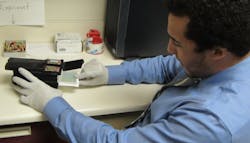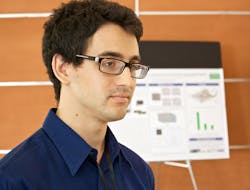Smartphone-based ELISA reader performs medical diagnostics at the point of care
A team of researchers from the California NanoSystems Institute at the University of California Los Angeles (UCLA) has developed a smartphone-based device that can read enzyme-linked immunosorbant assay (ELISA) plates at the point of care, with the same level of accuracy as the large machines normally found in clinical laboratories.
Related: Infectious disease control with portable CMOS-based diagnostics
Traditional ELISA testing, which identifies antigens such as viruses and bacteria in blood samples, is performed with small transparent plates that resemble honeycombs, typically with 96 tiny wells. Samples are placed in the wells first, followed by small amounts of fluid containing specific antibodies that bind to antigens in the samples. These antibodies are linked to enzymes, so when a substance containing the enzyme’s substrate—the molecule the enzyme acts upon—is added, the resulting chemical reactions cause a change in color. This color change is then analyzed to detect and quantify any antigens that may be present.
The new device, which is created with a 3D printer and attaches to a smartphone, illuminates the ELISA plate with an array of light-emitting diodes (LEDs). The light projects through each well and is collected by 96 individual plastic optical fibers in the attachment. The smartphone transmits the resulting images to UCLA servers through a custom-designed app. The images are then analyzed by a machine-learning algorithm that the researchers wrote for this purpose, and the diagnostic results are sent back to the phone within about one minute for the entire 96-well plate. The app also creates a visualization of the results for the user.
This mobile platform was compared with the standard FDA-approved well-plate readers in a UCLA clinical microbiology laboratory. The ELISA tests included those for mumps, measles, and herpes simplex viruses 1 and 2. With a total of 571 patient samples used in the comparison, the mobile platform achieved 99.6 percent accuracy in diagnosing mumps, 98.6 percent for measles, and 99.4 percent each for herpes simplex 1 and 2.
The research was led by Aydogan Ozcan, associate director of the California NanoSystems Institute, along with Dino Di Carlo, professor of bioengineering, and Omai Garner, associate director of clinical microbiology for the UCLA Health System. UCLA undergraduate Brandon Berg was the study’s first author, and two other undergraduates also contributed to the research.The research team is looking to adapt the basic design of their ELISA cell-phone reader to create smartphone-based quantified readers for other important medical tests, Di Carlo says.
The UCLA team included researchers from electrical engineering, physics and astronomy, bioengineering, pathology and laboratory medicine, and surgery, as well as the California NanoSystems Institute and the Jonsson Comprehensive Cancer Center.
Full details of the work appear in the journal ACS Nano; for more information, please visit http://dx.doi.org/10.1021/acsnano.5b03203.

